
For this month's Garden Bloggers' Bloom Day and Foliage Follow-Up, I decided to change things up. Instead of focusing on all the bright colors in my tiny "sunny" garden (I'll do that next month), I thought I'd share a few plants blooming and brightening the shade this month.
Starting with the Asiatic Lilies in the first photo above: Believe it or not, they only receive a small bit of direct sun in the afternoon. That may not the best textbook advice, but it seems to work in a little pocket of light on the northwest corner of the house.
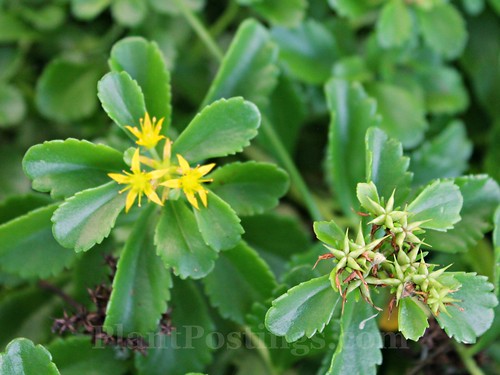

Sedum kamtschaticum grows in several places here and there, and thrives in dappled shade. Its tiny, bright yellow flowers bloom in early to mid-summer. The flowers and foliage make great groundcover companions with blue Juniper.

Dead Nettle (Lamium maculatum) keeps right on blooming. And when it's not blooming, the foliage is attractive on its own.
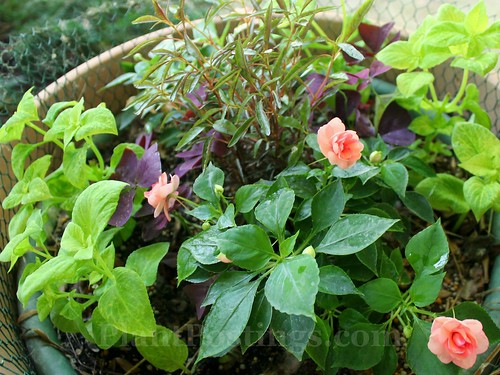
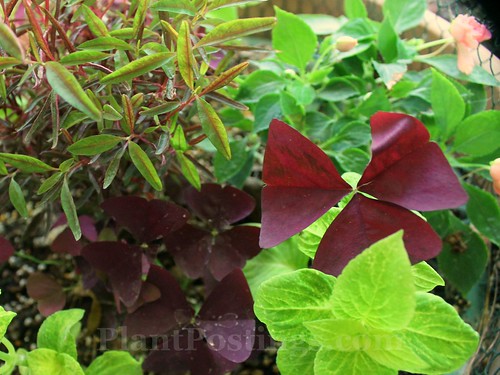
I'm pleased with the potted plants--a complementary contrasting combination of Oxalis triangularis 'Charmed Wine,' Double Impatiens 'Fiesta,' Solenostemon scutellarioides 'Wizard Golden,' and Alternanthera ficoidea 'Red Thread.'
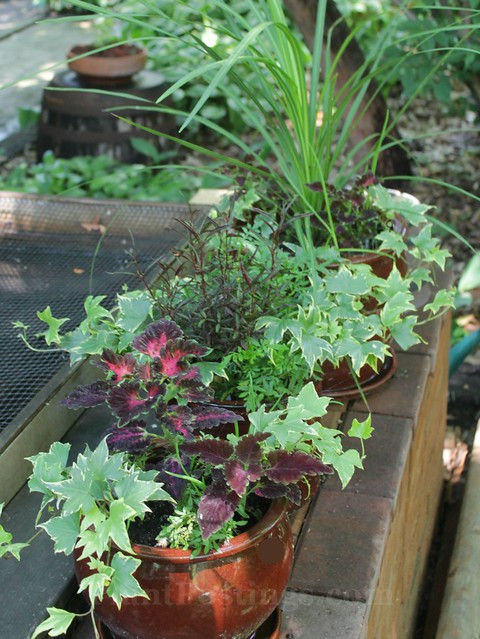
In the back, edging the pond, I combined variegated English Ivy (Hedera helix) with various Coleus varieties, a Spike plant (Cordyline indivisa), and more Alternanthera.
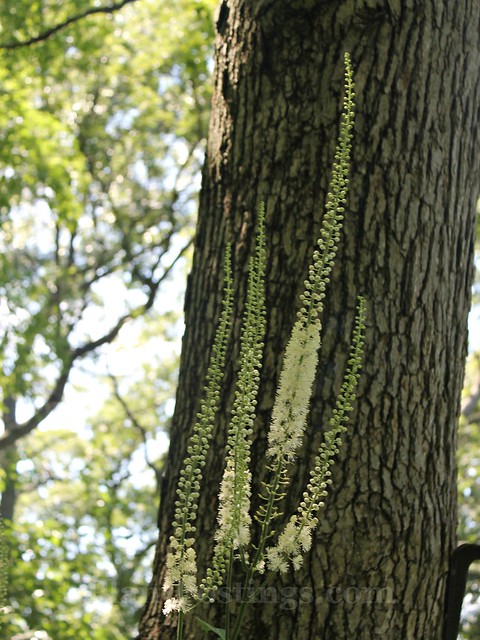

Bugbane (Actea racemosa) grows to its maximum height (at least seven feet, when in bloom) in my shady garden. It hangs around the big, old Oak trees and the Ostrich Ferns, which give it support and framework. I like the Maple-shaped foliage, too.

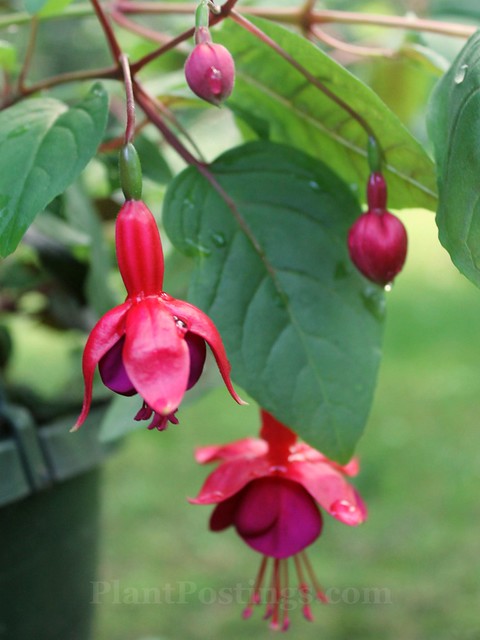
Who can deny the beauty and usefulness of pendulous Fuchsias? Top photo is 'Dollar Princess,' which I'm growing as an annual "shrub," until we decide which native shrubs to plant in its place. Bottom photo is my favorite Fuchsia: 'Marenka.' The hummingbirds love this plant.
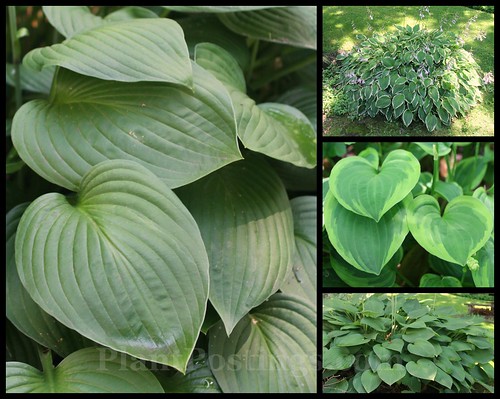
And, of course, the Hostas. We have several varieties, and the total count of actual Hosta plants must be more than 100. I take them for granted.
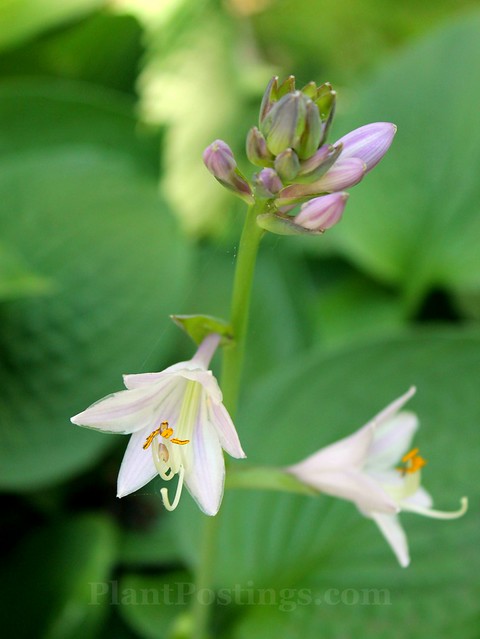
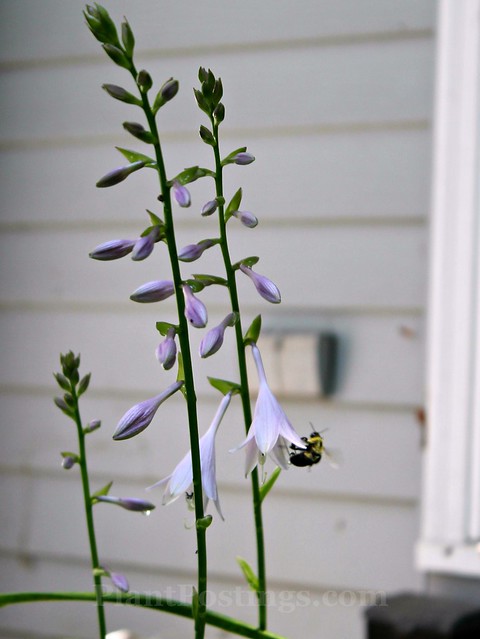
I also take for granted their delicate flowers. They seem to be especially popular with hummingbirds, bees, and sphinx moths. Hosta flower spikes are great for cut flower arrangements.
Some plants this year seem delayed in their blooming. I'm thinking various factors weighed into this, including earlier tree foliage in May and cooler-than-normal temperatures in June.
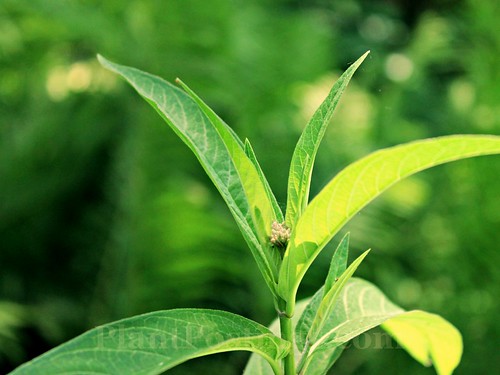
Swamp Milkweed (Asclepias incarnata) was in full bloom by early July last year. This year, in mid-July, it's still budding.
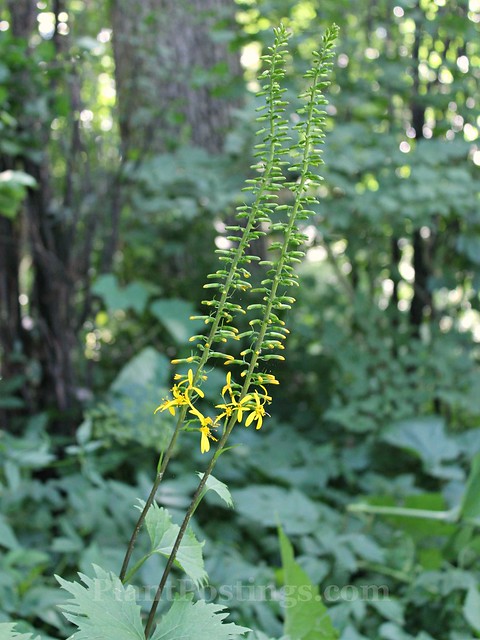

Ligularia stenocephala ('The Rocket') spikes up through the green with its bright yellow blooms, just beginning to open. Its leaves remind me of a Dr. Seuss-style heart.

I'm a big fan of chartreuse foliage. Anise Hyssop 'Golden Jubilee' (Agastache foeniculum) shines among its more modest neighbors. The light, lavendar-blue buds and flowers contrast pleasantly with the foliage.
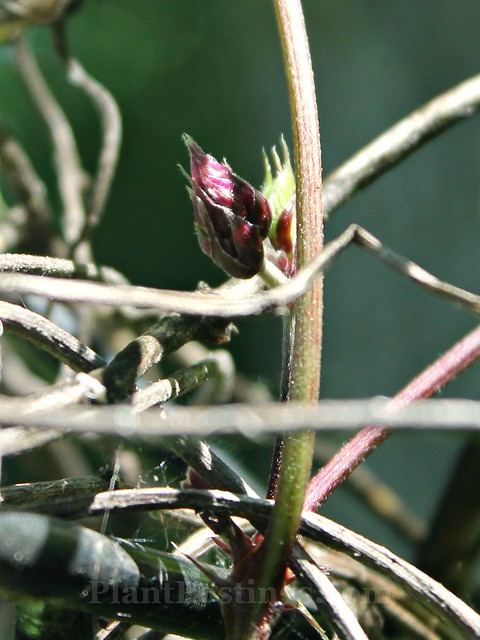

And then there's my favorite climber: Hyacinth Bean vine (Lablab purpureus). The purple flowers are just about to make an appearance. But its foliage captures the eye at any time.
What's blooming and brightening your garden this month? To compare notes with gardeners around the world, check out Carol's Garden Bloggers' Bloom Day and Pam's Foliage Follow-Up.
Lovely shade plants, I´ve lots of Hostas too and love them except when slugs and snails attack them, but this year it is not too bad. I think the contrasting combination of pot plants looks great! Your Lalblab purpureus is wonderful, I had to find out on google because I never heard of this climber before. Very nice, I always want to try something new, so may be you will see this one on my blog too in the future years.
ReplyDeleteThanks! Yes, the slugs and rabbits can do some major damage with the hostas. But I have so many, it's hardly noticeable. The slug damage seems worse in years when we have too much rain. Re: the potted plants -- thanks! I was pleased with how they turned out. They're still taking some time to fill in, but I'm liking them more and more as the summer wears on. I highly recommend the Hyacinth Bean vine. This year's plants were grown from last year's seeds. As long as I can do that, I will continue to do so. :)
DeleteSo many interesting plants, Beth! And, I love the quality of your pictures!
ReplyDeleteSome of these plants are not blooming yet in my garden: Agastache, Actea r..
I was able to keep my Ligularia alive only in the container - otherwise, it'd be eaten by slugs.
I never had Hyacinth Bean vine in my garden. What lovely leaves!
Thank you, Tatyana! I'm surprised your Agastache and Actea aren't blooming yet--I would have thought you'd be ahead of me. The Ligularia plants were here when we moved in and were well-established. They're nice, bright highlights in a shady garden. I'm seriously in love with Hyacinth Bean vine. It's an unhealthy addiction.
DeleteThere's so much gorgeousness in your shady plant world, it's hard to pin down a favorite. I love Fuchsias-so beautiful, but I'll have to enjoy yours, as we're just too hot! Your pollinators are happy--always good to see that! Beautiful photos!! Happy blooms and foliage days to you!
ReplyDeleteThank you, Tina. The Fuchsias do seem to prefer the milder parts of summer here, too. And, of course, they're in the shade which helps. If we have a very hot summer, they kind of go dormant until the fall. Yes, the pollinators are numerous now that the hostas are flowering. It seems everywhere I look, there are numerous bees of all types flitting here and there. It makes me happy. :)
DeleteIt's impressive how adaptive some plants are, as several of those I have in full sun in my garden. Love the bugbane! I have always wanted one in my garden, and just planted a bareroot one this spring. Unfortunately I put it in a spot that still got too much sun for it, and had to move it so it didn't fry. Now it's recovering, and I can't wait for it to bloom!
ReplyDeleteYes, I'm sure the Asiatic Lilies would be happier in more sun. They do grow toward the sun, of course, and they tend to lean on the fencing. But they look kind of pretty that way. I planted them so many years ago--but they keep on blooming year after year. The Bugbane does seem to love the dappled sun. The only issue with it is the scent--but apparently that's where it got its name. Maybe it helps to keep the mosquito population here just a little smaller. ;-)
DeleteSometimes in the midst of the riot of colorful daylilies and coneflowers in my garden right now, I forget to notice the smaller blooms in the shade. They may be subtle, but they're still beautiful, as you have demonstrated so well here. You've reminded me that I forgot to plant Hyacinth Bean this year--darn! I'm curious about your Agastache. I've only seen 'Golden Jubilee' growing in full sun, but if you grow it in shade, I'm definitely going to add some to my shade garden.
ReplyDeleteThank you, Rose! I'm always tempted to rave about the flowers in the sun because they're so dramatic. But this blog is about a (mostly) shade garden, so I thought I'd better give the shade plants a little stage time. 'Golden Jubilee' would probably be happier in full sun, and it would be larger and taller. But it's doing OK here in dappled sun. It's near the Swamp Milkweed. Both plants get sun off and on throughout the day--so it's not full shade.
DeleteWhat can I say - I love your garden!
ReplyDelete:) :) :)
PS - It's interesting because we are so far apart geographically, but my Asclepias incarnata (first year in the garden) is just starting to bloom too!
Why, thank you, Aaron. It's a little messy and wild, but it's definitely wildlife-friendly. That is fascinating about your A. incarnata just blooming now, too. I think mine took a little longer the first year, too. I'm amazed at the difference from last year to this year, though!
DeleteHi Beth, so many interesting plants are growing and blooming in your garden! I especially love the Bugbane, the Dead Nettle and of course the Asiatic Lily. It is amazing to me that yours blooms in quite a bit of shade. That just shows that it is always worth experimenting in the garden!
ReplyDeleteWarm regards,
Christina
Thank you, Christina. Garden experimentation is part of the joy of it all! I have so few areas of bright sun, that I have to try to be inventive. Sometimes it works, sometimes it doesn't. ;-)
DeleteVery nice, Beth. Shade is welcomed in the heat and dry here. I too showed shade plants. Your hosta looks good with all the rain you must have had.
ReplyDeleteThank you, Donna. I agree: I appreciate the shade when it's super hot (as it will be this weekend!). Actually, we haven't had as much rain as our neighbors just to the south in Illinois. It's kind of strange how different our weather has been from theirs this summer. We've had just enough rain to keep the plants happy. It's been a little cooler than normal, but the forecast says that's about to change. Bring on the summer heat, I say!
DeleteLove your Asiatic lilies and coleus planters.
ReplyDeleteThank you, Heather. I've been struggling with the Coleus plants the past several years. They always seem to perform better when it's hot, so this weekend should perk them up!
DeleteI can't believe your Hostas are so pristine. Their blooms as you say are often overlooked but loved by the wildlife in my garden too.
ReplyDeleteThose pots by the pond make a lovely statement too. Your shady areas are gorgeous Beth.
The Hostas are in very good shape this year. We've had just enough rain to keep them healthy, but not enough that the slugs and earwigs are doing major damage. I know some people dislike Hostas. I can't dislike them, because they were here when I moved in and they form the structure of this garden. Plus, as you say, the native pollinators love them even though they aren't native plants. Thank you, for your kind comments, Angie. :)
DeleteLovely!
ReplyDeleteI agree, we can take our Hostas for granted. I do love them. Maybe it is because they are so true to us? :-)
Thanks, Carla. The Hostas form the architecture of this garden. It seems the previous owner used them to demarcate the edges of the garden, and it seems to work here. If I were starting from scratch, I'm not sure I would plant so many, but they are easy care here.
DeleteMy best success with Oriental lilies was in a shady spot too, going against everything I had heard. Your shady characters are looking good.
ReplyDeleteThanks, Ricki. I started out planting the lilies here and there, but over the years, as the rabbits have nibbled them to the ground, I've moved most of them to one area, with strong double fencing all around them. I make do with the limited speckles of sun on this property. :)
DeleteI have so much shade. I need to find a spot for that bugbane! Love the leaves on the ligularia. Very cool. :o)
ReplyDeleteI understand. That's the aspect of this garden, too. I know I keep recommending the Bugbane. But it's probably my most reliable, drought-tolerant, shade-loving plant. It has a strong odor, but I suppose that helps keep some of the bad bugs away. Ligularia, also a shade-lover, seems to prefer more moisture. It blooms quickly and goes dormant during a drought.
DeleteVery pretty. Love that first photo especially. You have a lot of shade-loveliness going on. Thank you too for being so generous with your visits, time & comments. I have truly appreciated them.
ReplyDeleteThanks, Kathleen. It's always a pleasure to visit your stunning blog! There's plentiful green in this shady garden, with patches of other colors here and there. :)
DeleteI didn't know that Hosta flower spikes did well in arrangements! I have so many of them in the north facing shade garden and it never occurred to me to use them inside—thanks for that tip. You garden is looking lovely. I've not success with a freestanding Fucsias, but seeing yours make me want to try again. Love, Susie
ReplyDeleteHi Susie: Some Hostas have longer vase lives than others. For some reason, it seems the giant-leafed dark green and bluish varieties have heartier blooms. I'm sure it varies more than that, but that seems to be the case with my Hostas. Also, if I catch the stems when they're just beginning to flower, they seem to last longer (often the case for many cut flowers). This is the first time I've tried a Fuchsia directly in the ground. It seems to be working well so far. It's petite, but that spot doesn't have abundant space.
DeleteThat's a beautiful lily & you've done a wonderful job with your pots. I'll have to keep those selections in mind as I want to place some pots on my front porch at some point & it is on the north side of our house.
ReplyDeleteHostas are one of my favourite plants - there are so many different varieties to choose from and I love them all!
Thanks, Margaret. North-facing, shady areas can be tricky, indeed! The Lilies were healthy and colorful this year. Mine are finished blooming now, but some Daylilies are just coming on. Summer fun continues!
DeleteMy experience is that many more plants can grow than we generally expect in what might be considered "shade". If the shade is dappled, or if there is a bit of strong afternoon sun, the number of plant possibilities expands dramatically. I really like your Cordyline!
ReplyDeleteVery true, Jason. We do what we can with dappled sun that we have. ;-) Some plants simply don't bloom as prolifically in shade, or they often have smaller blooms in shade, but sometimes that can be a good thing. And many plants (like the Lilies) seem to adapt. In the past, I've gone overboard with the Cordylines in the centers of pots. This year I only bought two, to create more diversity in the pots.
DeleteWhat an interesting selection of shade plants and as always, great photos. Your lily is so beautiful and no sign of damage, do you get lily beetle there?
ReplyDeleteThank you, Chloris! I don't recall having a problem with a lily beetle. I think earwigs and Japanese beetles can be a problem with lilies, but they seem to be more of a problem in my potager, where I use Marsh Hay instead of bark mulch.
DeleteI love all your shade garden plants. I've noticed that shade gardens here have fewer weed problems so I've been working on some. Your hostas are so lovely, I've noticed how some are very good bloomers, and some with white flowers are even fragrant. I like the little Impatiens flowers that look like little rosebuds, I find them hard to keep alive. So cute!
ReplyDeleteThanks, Hannah. I've found that the weeds are simply different in the shade. Several of our most difficult invasive plants here in this part of the world are actually shade-loving plants (Garlic Mustard, Creeping Bellflower, the Helleborine Orchid). The fragrant Hosta flowers are wonderful--which reminds me, I should check mine for scent. ;-) The double-flowering Impatiens have been more successful for me in recent years because the singles seem to be more susceptible to Downy Mildew.
DeleteIt is interesting to see what blooms in the shade for you! I had high hopes for actea, but it perished. Same with ligularia. I can grow some annual fuchsia and, of course, hosta, which, as you said, was easy to take for granted…until the voles discovered it! I lost count of the number of hostas I have lost to voles. I hesitate to plant them in the ground now, though I can put them in bottomless plastic pots and sink those in the ground.
ReplyDeleteYes, that is fascinating, Deb. Actea is spreading here and definitely thriving! Both the Actea and Ligularia plants were here when we moved in. The Ligularia performs better with plenty of moisture and doesn't like a high heat/drought combo. The Hostas were also here when we moved in. Frankly there were so many of them that the extensive damage done by rabbits, voles, and slugs each year hardly makes a dent. The previous owner must have planted a huge quantity of Hostas! And of course, the groupings expand each year.
DeleteLovely shade flowers Beth, so much colour! My experience with lilies is that most of them do better in semi shade or full shade, with only a few exceptions. I grow Lilium regale in full shade and they are very happy there and flower for much longer than in sun. Marenka is a lovely fuchsia, I have it too and although I don’t have any hummingbirds, the bees love mine. And your Hyacinth Bean vine is just gorgeous, I remember the flowers from last year :-)
ReplyDeleteThanks, Helene. You certainly have experience with Lilies and yours are stunning! And, I agree, the shade can help to prolong the blooms--especially during hot summers. My Markinka Fuchsias are blooming profusely now. I think they liked our cooler-than-normal June. We are about to hit an extended hot spell, so it will be interesting to see how they adapt. Sometimes, they go a little dormant in the middle of the summer, but revive in the fall. Thanks for the tip last year that the Fuchsia fruits are edible. They're quite tasty!
Deletehummingbirds like fuchsias?
ReplyDeleteI need to watch quietly if our sunbirds do too.
Yes! The hummingbirds love the Fuchsias, and when they trail over the side of a hanging basket, they're in the perfect position for the hummingbirds to reach up for nectar. One of these days, I'll get a decent photo of them doing this. Your sunbirds are gorgeous, too. Here's a photo of one with a Fuchsia, so I guess they must like them, as well: http://shutr.bz/1Kikopj.
DeleteOh, these are all beautiful images. Love the Dead Nettle flowers; they look so exotic. Right now I have almost nothing blooming. Everything that wants to survive is going dormant so all your lush growth and bright colours are an extra special treat to see. Thank you!
ReplyDeleteThe Dead Nettle is so reliable here, but I have to keep it in check. We've had a great, near perfect growing season so far. Some of the summer flowers were delayed a bit, which delayed some of the pollinators, but now things are on track. The agricultural crops are thriving this summer, too. Further south, some of the states (Indiana, Illinois, Ohio), had significant flooding, but we didn't have that problem this year. And, thankfully, no drought so far (fingers crossed).
DeleteI like the lily and pot planting, so interesting.
ReplyDeleteFabulous Beth to see so much that will flower in the shade...I used to have mostly shade gardens and I would push the envelope and was so rewarded...beautiful flowers and foliage.
ReplyDeleteYour Asiatic lily is stunning! And hosta... the easiest plant to grow "up north." I try them out year after year here in TX. If I'm luck enough to keep them alive, they stay very small and rarely flower - completely unlike their behavior in WI. Growing up in Southeaster WI, on a shady property, they were the most reliable plant. I miss their big foliage, and multitude of different varieties. If ever I move back to the frozen tundra, I look forward to having an abundance of hostas again. And who doesn't love a plant that keeps on giving, which you can share with your family and friends?
ReplyDelete